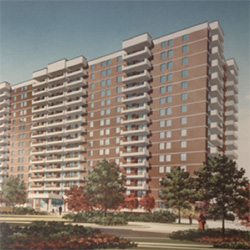There are some steps that can be taken to reduce second-hand smoke in multi-unit housing. These could include:
Document the source and extent of the problem
Use a log to track efforts to address the problem.
- Identify how smoke is entering units i.e. through a bedroom window, through a bathroom or kitchen fan or from an electrical outlet
- Identify where the smoke is coming from i.e., neighbour’s balcony or unit, outside smoking area or some other area
- Identify dates and times when smoke enters units to track how often and when smoke is a problem
- Identify when the problem started such as if smoke was a problem on date of moving in or when a new resident moved in
Track impact of second-hand smoke
Everyone has the right to reasonable enjoyment of their home. It is important to document the amount of smoke and how often the smoke enters units and how the smoke impacts residents. Residents will want to be able to document that the smoke entering their unit makes them unable to use their unit in a normal way or makes parts of their unit uninhabitable. A log can be used to track the impact of second-hand smoke.
- Find out how the smoke is entering units. For example, the smoke could be coming from an open window, under a door, from the bathroom or kitchen fan, through an outlet or through gaps between units.
- Try to find out where the smoke is coming from. For example, the smoke could be coming from a neighbouring balcony or unit or an outside smoking area.
- Track how often smoke enters a unit on a daily or weekly basis. Do you smell smoke all the time, or at certain times of the day? List dates and times that you smell smoke.
- Try to find out how much smoke is entering units. Ask: is the smell overwhelming, or is there just a whiff of smoke? Does the smoke stay in one area or does it travel to other areas of the home? Does the smoke stay in the unit for a long time or does it go away after a while?
- Think about when the problem started. Did the smell start as soon as you moved into your unit? Did you notice the smoke when a new person moved in?
Health impacts of smoke can be documented by:
- Writing down symptoms or illnesses caused by smoke, such as asthma attack, headache, burning and watery eyes, sore throat, chronic coughing, bronchitis, ear infections and heart problems.
- Thinking about whether the smoke is making a pre-existing health problem worse. Some health problems that can be made worse by smoke include asthma, allergies, heart disease, high blood pressure, fibromyalgia, and cancer.
- Writing down whether smoke causes anxiety or fear because of the potential or actual health impacts. Babies who are exposed to second-hand smoke have a higher risk of dying from Sudden Infant Death Syndrome (SIDS), so this is important to document.
Impact on use and enjoyment of unit can be documented by asking:
- Are members unable to live in parts of your home at times because of the smoke?
- Are members forced to stay out of certain rooms?
- Are members unable to open windows or balcony door?
- Are members unable to use balconies?
- Are members unable to use fans or heating system?
- Are members unable to use certain cupboards, drawers or closets?
- Have members been forced to leave home on certain days or at specific times to avoid the smoke?
- Are members friends and family members with health conditions unable to visit because of the smoke?
Collect other evidence
- Check the declaration, by-laws and rules. There may already be policies in place about behaviours or nuisances.
- Obtain written proof from neighbours, friends and family about the amount and frequency of smoke entering units.
- Get a physician/health care provider letter confirming that exposure to second-hand smoke makes you or your family members sick, or makes an existing condition or illness worse.
Sealing units to reduce second-hand smoke transfer
- Use caulk or spray-in foam around plumbing, electrical outlets, phone jacks, fixtures, cracks and gaps
- Close windows and doors
- Weather-strip windows and install door sweeps
- Cover or block heating/cooling grilles
- Fill or patch cracks in walls and ceilings
- Insulate air spaces around plumbing pipes
Investigating the ventilation
Make sure the ventilation system is working properly. According to the Canada Mortgage and Housing Corporation, most apartments built after the mid-1960s have corridor ventilation systems. These systems are designed to deliver outside air into corridors to maintain positive pressure. Air is continuously pushed under doors, thereby preventing odours from escaping individual units and leaking into the corridors and neighbouring apartments. Older buildings rely on air coming in through cracks and gaps for ventilation. In addition, many apartments have exhaust systems to ventilate the bathrooms and kitchens, with fans either right in individual units or located centrally elsewhere in the building.
- If smoke is entering units under the front door from other units, the property manager could check the ventilation system to make sure that it is working properly. Sometimes the systems operate on a timer and the schedule may need to be adjusted.
- Check to see if it is possible to restrict the amount of air exhausted through the ventilation system from units where there is smoking.
- If smoke is coming into units from a bathroom or kitchen fan, try the tissue test. Turn on the kitchen or bathroom fan and hold a tissue to the grille. The fan should be able to hold the tissue firmly in place. If it doesn’t, or if it blows instead of sucks, clean, repair or replace the unit.
- Clean, change or install new filters in the ventilation system.
- Restrict the amount of air exhausted through the ventilation system from units where there is smoking.
- Explore having unit pressurized to prevent air (and second-hand smoke) from leaking into the unit by having a professional install a HEPA-filtered (High Efficiency Particulate Air) heat recovery ventilation system.
- This system uses a fan to force fresh air into the unit, which prevents smoke from entering. For this system to work windows must be closed and windows and doors need to be well sealed.
- Note drawbacks to HEPA system such as expense and potential condensation problems depending on the climate. Many high-rise apartment buildings have pressurization systems in the hallways and pressuring individual units may interfere with the building ventilation system.
- Clean, change or install
While improved ventilation can remove the odour of smoke and the source of eye and throat irritation, no ventilation system can reduce exposure to the toxic chemicals in second-hand smoke to an acceptable level.
Speak with residents and co-op supports
- Talk to the person who is smoking. They may not realize that the smoke is a problem for you. Focus on solutions such as asking the neighbor to smoke outside.
- Share information about second-hand smoke in co-op newsletters or online site for residents.
- A survey of members about second-hand smoke exposure and interest in a no-smoking policy for the condominium could be conducted to determine how to move forward.
- Consider contacting co-op support agencies and networks such as the Co-operative Housing Federation of Canada(Ontario), and Ontario Co-Operative Association
Speak with the co-op board
Co-ops decide things democratically, either by majority vote of the board or members, depending on the issue. Before taking any action, read co-op’s by-laws to understand how decisions are made. Every housing co-operative in Ontario has its own unique by-laws or rules that determine how it is managed.
- Ask the co-op board of directors to discuss second-hand smoke at the next board meeting or annual general meeting.
- Members could show their log of second-hand smoke concerns, letters of support, and talk about how smoke disrupts their life and affects health. Members can show what they have done and suggest specific solutions.
- Mediation could be one way to solve the problem.
If the board of directors is not supportive, members could try to requisition the board to call a members’ meeting.
- Section 79 (1) of the Act provides that 5% of the members of a co-operative may requisition the directors to call a general meeting of the members for any purpose connected with the affairs of the co-operative and that is not inconsistent with the Co-operative Corporations Act.
- If the directors do not call and hold a meeting within 30 days from the date of the deposit of the requisition, any of the requisitionists may call the meeting, which shall be held within 60 days from the date of the deposit of the requisition under Section 78 (4)).
- Where a bylaw or resolution is passed at the general meeting of the members, it is as valid and effective as if it had been passed at a meeting of the directors duly called, constituted and held for that purpose, and if the resolution or bylaw is passed by at least two-thirds of the votes cast (one vote per member), it shall be conclusively deemed to be a special resolution or a bylaw, as the case may be, for the purposes of this Act(section 70 (6)).
Keep all records of correspondence with the members, corporation or property manager concerning second-hand smoke.
For additional assistance, refer to Co-operative Housing Federation of Canada (Ontario), Ontario Co-Operative Association, Co-operative Corporations Act, and consider reaching out to a legal professional with expertise in co-op law.
Other steps that can be taken if second-hand smoke is an ongoing problem:
- If second-hand smoke exposure is a problem, write a complaint letter to the co-op board requesting they take action.
- Provide documented evidence about the source of the smoke, frequency, duration, health impact and the impact on the use and enjoyment of the unit.
- Include other supporting evidence such as a physician/health care provider letter about health impacts or letters from friends and neighbours that confirm the problem.
- Identify steps taken to resolve the problem to date.
- Propose possible solutions and ask for a response by a specific date.
If a co-op board refuses to act or smoke cannot be reduced or eliminated to a suitable level, there are a few last resort measures that can be taken. Before taking formal steps such as opening a lawsuit, it is recommended that you seek legal advice.
- Explore an injunction to prevent person(s) from smoking in the building. You need to seek legal advice for how to proceed.
- Apply to the Human Rights Tribunal of Ontario






